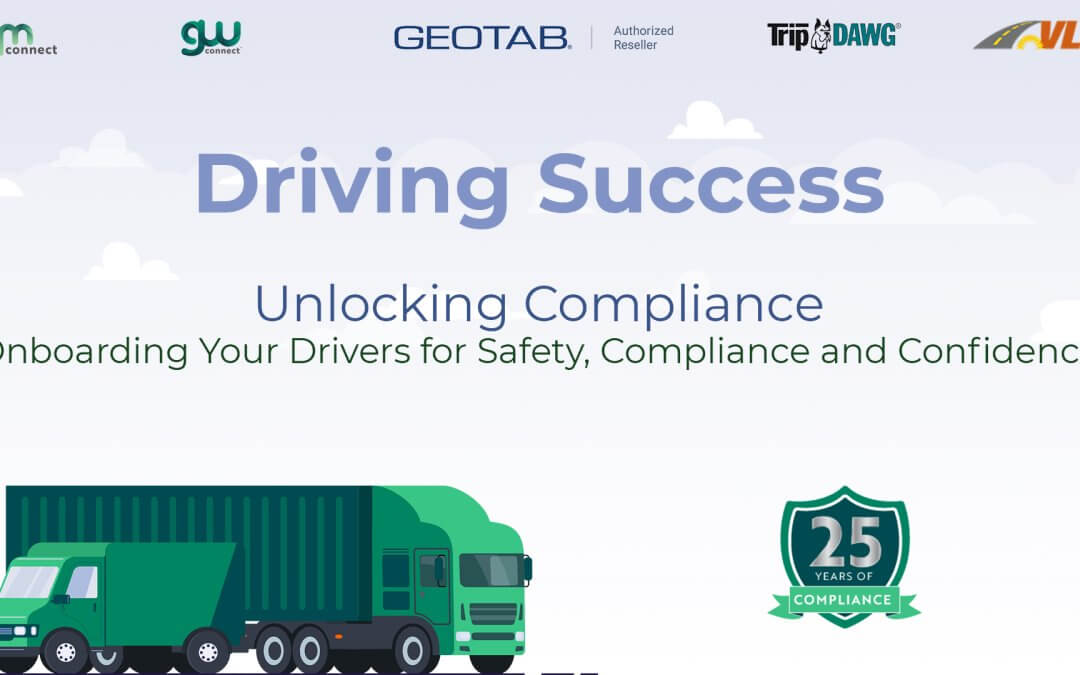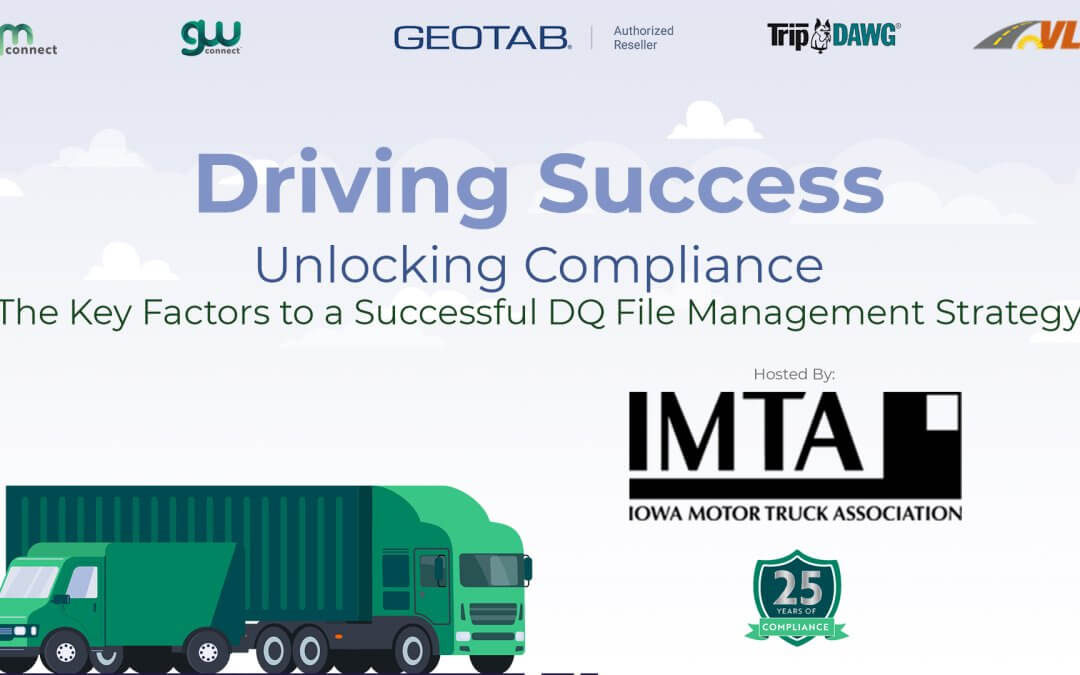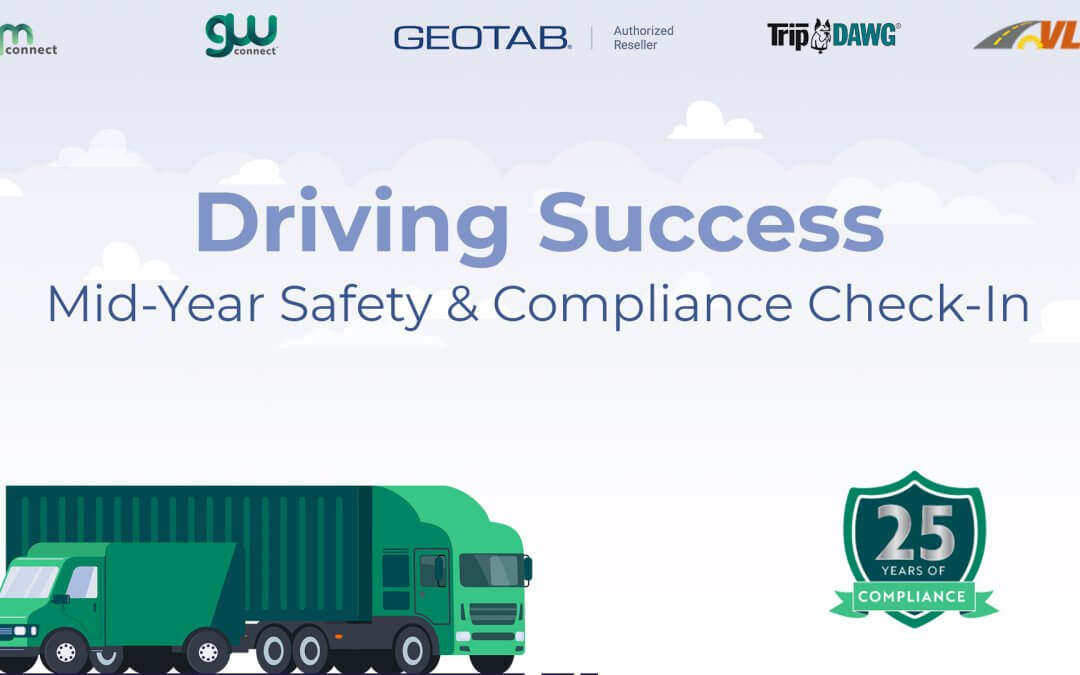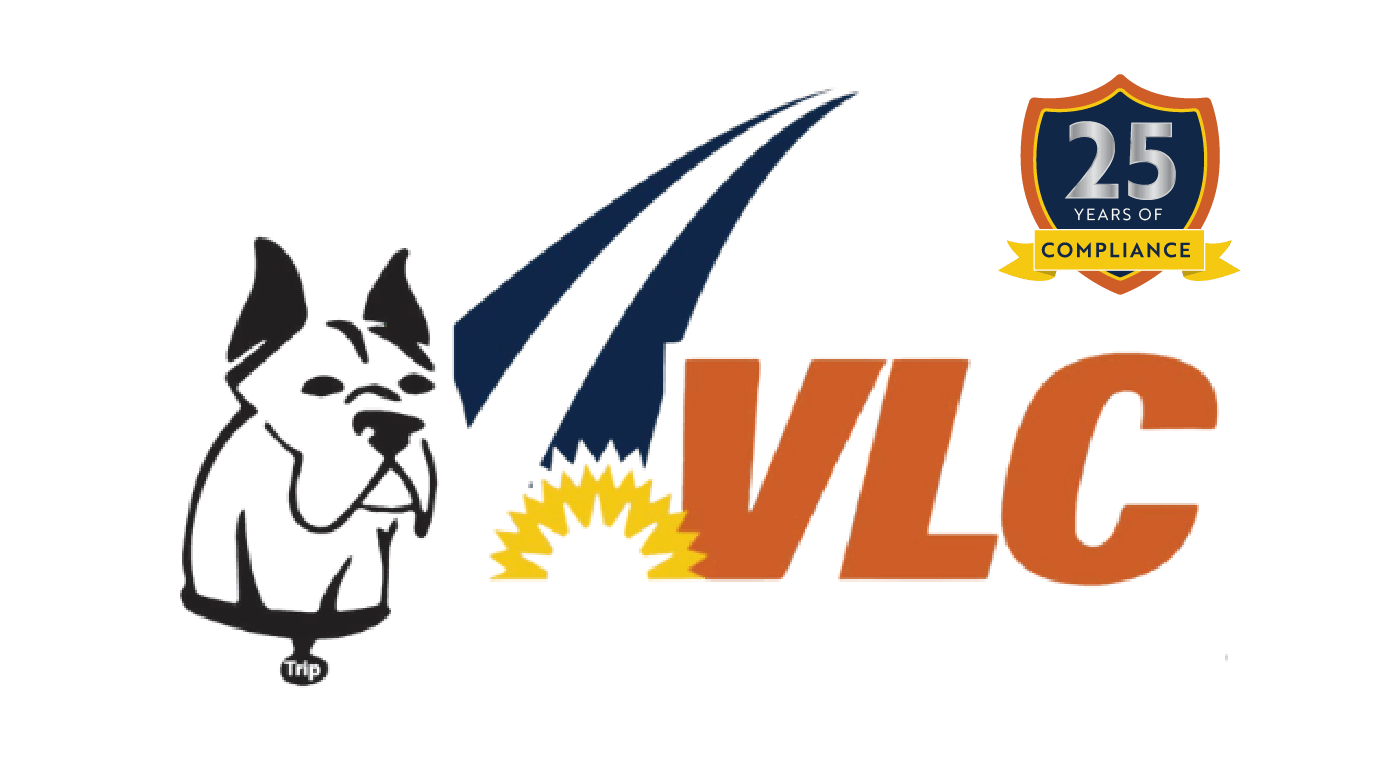
Driving Success Webinars
Driver onboarding for safety and compliance has never been more critical, especially as fleets head into a new year filled with evolving regulations and higher expectations. In our December webinar, we explored how a strong onboarding workflow not only supports cleaner audits but also builds safer operations, reduces risk, and strengthens driver confidence from day one. This recap highlights the biggest insights and practical steps fleets can take to elevate their onboarding process right now.
New and Upcoming Regulations That Impact Onboarding
Several recent and proposed changes will directly affect how you bring new drivers into your fleet:
English Language Proficiency
Drivers are getting placed out of service because they cannot meet English language proficiency requirements during inspections.
Fleets need a consistent way to vet English skills during onboarding, while still staying within HR and discrimination laws. The application, interview, and training process can all serve as informal checkpoints—if you design them that way.
Non-Domiciled Driver Licensing
Non-domiciled CDL holders are under heavy scrutiny. A temporary stay has forced FMCSA back to the drawing board, but many licenses are still on hold or revoked because of how they were issued or renewed.
If your onboarding workflow is not double-checking licenses with an MVR and ongoing monitoring, you may be onboarding drivers who appear valid on paper but are not legal to operate.
January Medical Card Changes
Electronic medical card reporting will change how you verify qualifications and track renewals. For DOT drivers, that means your onboarding and renewal workflows must be built around electronic status—not just a card in a wallet.
Why the DOT Application Is Your First Safety Checkpoint
The DOT application is your first real touchpoint with a driver and the foundation of the driver qualification file. It needs to be:
- Complete – No missing sections, unchecked boxes, or vague answers
- Accurate – At least 10 years of consecutive employment history, with all gaps over 30 days explained
- Driver-completed and signed – The driver must provide and certify the information
This is also a natural place to uncover:
- Gaps in experience or work history
- Possible return-to-duty situations
- English language challenges that could lead to out-of-service violations later
A sloppy application almost guarantees sloppy files and weak safety documentation down the road.
Safety Vetting: Beyond “Checking the Box”
Once the application is complete, the real vetting begins. The webinar highlighted several must-have steps:
- Pre-employment drug and alcohol testing
- Clearinghouse full query plus driver consent
- Pre-employment MVR to catch revoked, suspended, or non-domiciled issues
- Drug and alcohol questionnaire to identify past refusals, failures, or return-to-duty situations
- PSP report (optional but strongly recommended) to see a broader safety history
- Road test even when a valid CDL allows you to skip it on paper
The message was clear: compliance and safety are not the same thing. You can technically “meet” the regulation and still put an unsafe driver in a very expensive asset with your DOT number on the side.
Frequently Missed Requirements
Several items came up again and again as common weak spots:
- Clearinghouse queries not run at all, not completed, or not followed up when the driver never approves them
- 10-year employment history without documented gaps or clear explanations
- Safety verifications treated as a checkbox instead of real outreach by phone, email, and documented attempts
- Drug and alcohol questionnaires skipped or buried in paperwork
These may look minor on the surface, but they become critical when an auditor or an attorney starts pulling on threads after a crash.
How Solid Onboarding Protects Safety, Liability, and Operations
The webinar tied onboarding to four big outcomes:
1. Safety
Proper vetting helps ensure qualified, alert, and trained drivers are behind the wheel. Road tests, continuous monitoring, and a complete application all reduce the odds of preventable crashes.
2. Compliance and Documentation
DQ file compliance starts on day one. Incomplete or missing documents are among the most common FMCSA violations. Digital, organized files with clear audit trails give you a strong defense in audits and post-crash investigations.
3. Operational Integrity
Expired CDLs, missing medical cards, or unreported suspensions stall freight, create delays, and disrupt schedules. Continuous license monitoring and clear workflows keep trucks moving.
4. Reputation and Relationships
Your CSA score and safety track record speak louder than your marketing. A single preventable crash or pattern of violations can damage relationships with shippers, brokers, and insurers—and increase onboarding costs through higher turnover.
Fixing Workflow Gaps and Connecting Your Teams
One of the biggest themes was cross-department communication. HR, Safety, Fleet, and Operations often work in silos, each with their own priorities and checklists. That leads to:
- Inconsistent onboarding from one location or manager to another
- Confusion about who owns Clearinghouse, I-9/E-Verify, and verifications
- Missed steps when staff changes or people leave
The solution is a single, documented workflow that everyone follows, supported by tools that make it easy to:
- Standardize the DOT application
- Track tasks across HR and Safety
- Verify work authorization and non-domiciled status
- Maintain continuous license and safety monitoring
Building a Cohesive Safety Program, Not Just Checkpoints
The webinar closed by zooming out: onboarding is not a one-time event. It is the start of a continuous, cohesive safety program that should include:
- Clear, consistent onboarding workflows
- Continuous license and MVR monitoring
- A training program that actually changes behavior
- An accountability system that combines ELD data, camera alerts, incidents, and coaching
- Telematics tools aligned to your specific risk profile—not just “everything” for its own sake
When all of that connects, onboarding stops being just paperwork and becomes the first step in a safer, more resilient fleet.
Ready to Strengthen Your Onboarding Process?
If you want a safer fleet, cleaner audits, and fewer surprises on the road, it starts with building a consistent onboarding workflow.
Our team can help you streamline your process, close compliance gaps, and set your drivers up for long-term success.
Reach out today to review your current onboarding workflow and identify immediate improvements you can make before the new year.

Driving Success Webinars
Driver qualification file management is no longer a “nice to have.” It is one of the most important foundations of your safety and compliance program.
Over the past few years, the FMCSA has shifted its focus more directly toward drivers themselves. English language proficiency, non-domiciled CDLs, digital medical cards, clearinghouse enforcement, and proposed fentanyl testing have all increased the pressure on fleets to get driver qualification right from day one.
If your driver qualification file management strategy is based on paper folders, spreadsheets, and siloed systems, you are taking unnecessary risks with your CSA scores, your insurance premiums, and your reputation.
This post breaks down what successful fleets are doing differently and how you can build a stronger driver qualification file management strategy that actually works in the real world.
Why Driver Qualification File Management Matters More Than Ever
FMCSA activity around drivers has intensified. That includes:
- English language proficiency enforcement
- Digital medical card implementation and new MVR requirements
- Ongoing clearinghouse queries and violations
- Increased attention on non-domiciled CDLs
- Proposed updates to drug testing panels
At the same time, the basics have not gone away:
- You still need complete and accurate driver qualification files
- You still need annual reviews and MVRs
- You still need to document due diligence for onboarding and ongoing management
When driver qualification file management slips, you feel it everywhere:
- Fines and penalties for incomplete or missing documents
- Out-of-service orders when credentials are expired
- Higher CSA scores and increased inspection frequency
- Insurance premium increases or coverage challenges
- Higher operational costs from risky driver behavior and turnover
Your drivers are the face of your company. Their behavior on the road, and the way you document that behavior, directly impact your safety and risk profile.
Build a Strong Driver Qualification Foundation From Day One
A successful driver qualification file management strategy starts with onboarding. If you set clear expectations and collect complete information up front, you reduce risk throughout the driver’s life cycle.
Go Beyond the Basic HR Application
A standard HR application is not enough for DOT compliance. A DOT-compliant application asks for more detailed information, including previous addresses, complete employment history, and driving history that HR systems often miss.
Make sure your process includes:
- A DOT-compliant driver application
- Pre-employment drug and alcohol testing
- Clearinghouse pre-employment query
- Road test or equivalent evaluation (even if not strictly required for CDL drivers)
- Pre-employment MVR for every state where the driver held a license
- Safety verifications from previous employers
- A drug and alcohol questionnaire to confirm the driver is not in a return-to-duty process
When you treat the driver qualification file as the first and most important record of the driver’s employment, you set the tone that compliance matters.
Habits of Fleets With Strong Driver Qualification File Management
The fleets that consistently stay compliant and audit-ready share several key habits.
1. Standardize and Streamline Onboarding
Successful fleets:
- Use a standardized, guided application and onboarding workflow
- Collect all required documents before the driver gets behind the wheel
- Reduce back-and-forth by making it easy for drivers to upload documents quickly
- Use checklists or software workflows so “anyone can do it” without missing steps
Consistency is what keeps gaps from forming over time.
2. Track Renewals Proactively, Not Reactively
Outlook reminders and spreadsheets are easy to ignore. They also get out of date the moment someone exports or closes a file.
Instead:
- Automate reminders for medical cards, CDLs, TWIC, HAZMAT, and other credentials
- Send alerts to both drivers and admins
- Build renewal tracking into your driver qualification file management system, not a separate calendar
Proactive renewal management prevents drivers from being dispatched with expired credentials.
3. Ditch Spreadsheets and Paper as Your “System”
Spreadsheets and paper files can be useful backups, but they are not a reliable system of record.
Stronger programs:
- Use one centralized digital system as a single source of truth
- Allow multiple team members secure access to the same up-to-date data
- Eliminate version confusion from local spreadsheets or files on shared drives
As soon as a spreadsheet is downloaded or printed, it is already out of date.
4. Maintain Clear Communication Across Departments
Driver qualification file management is not only a safety issue. It touches:
- Safety and compliance
- HR
- Dispatch
- Risk and insurance
- Sometimes even maintenance
When these teams work in separate systems, delays and mistakes are almost guaranteed.
A better approach:
- Give each department visibility into key driver status information
- Make sure everyone can see upcoming expirations and outstanding tasks
- Share responsibility for compliance instead of letting it sit with one person
5. Stay Audit-Ready All Year
Being audit-ready is not something you can build in a weekend.
Strong programs:
- Keep driver qualification files organized, complete, and accessible at all times
- Centralize documents instead of scattering them across email, portals, and paper files
- Implement internal checks and balances to identify missing items before an auditor does
- Use tools that show which documents are missing or expired so you can act quickly
A “happy auditor” experience starts with clean, complete files and quick retrieval.
6. Engage Drivers Through Self-Service and Transparency
Drivers play a central role in driver qualification file management. They are the ones who must:
- Renew their medical cards
- Renew their CDLs
- Complete assigned training
- Report issues and incidents
Modern programs support drivers by:
- Giving them access to a secure portal
- Allowing them to check their own status from a phone
- Letting them upload documents directly from the road
- Automating reminders so they are not surprised by deadlines
When drivers have visibility and feel heard, they are more likely to follow the process.
7. Manage Incidents, Training, and Behavior in One Place
Driver qualification file management is more than static documents. It also includes:
- Accidents and incident reports
- Citations and violations
- Corrective action and coaching
- Drug and alcohol events
- Training completion and participation
Storing this information in one system makes:
- Annual reviews simpler
- Trend analysis possible at both driver and fleet levels
- It easier to show due diligence if a claim or lawsuit arises
Data that cannot be searched, compared, or reported is just noise. The value comes from turning it into actionable insight.
8. Follow Driver File Retention Rules
Knowing FMCSA retention rules is part of a healthy driver qualification program.
In general:
- Key pre-employment documents (application, initial MVR, initial drug and alcohol test results) should stay in the file for the entire time the driver is employed
- Other records may be subject to the three-year retention standard
Avoid keeping unnecessary expired documents in the main file. Store what is required, keep it organized, and make sure it is easy to demonstrate that you followed proper protocols from the start.
Move From Habits to a Driver Qualification Compliance Culture
Good habits are a strong start. However, long-term success comes from building a culture that supports driver qualification file management across the organization.
That culture connects:
- Leadership
- Safety and compliance
- HR
- Dispatch
- Drivers
A useful framework is a simple continuous improvement cycle:
- Review
- What are you tracking today?
- Where are the biggest pain points?
- Are you missing documents, renewals, or follow-up actions?
- Measure
- Number of expired or missing documents
- Average time to onboard a driver
- Violations per driver per year
- Percentage of files that are truly complete
- Adjust
- Update workflows and procedures
- Eliminate manual steps where possible
- Implement technology or tools that close gaps
- Train
- Align all departments on the new process
- Hold regular check-ins (monthly, quarterly)
- Confirm that people understand the “why,” not just the “what”
Then repeat: review, measure, adjust, and train again. Compliance is not a one-time project; it is an ongoing practice.
Four Actions to Improve Driver Qualification File Management This Quarter
If you are wondering where to start, focus on these four moves:
- Centralize Your Driver Qualification Data
Move away from scattered spreadsheets, email attachments, and isolated systems. Use one platform as your system of record for driver qualification file management.
- Implement Continuous Monitoring Where Possible
Continuous license and CSA monitoring helps close gaps between annual MVR pulls. It surfaces risk faster and protects you from surprises.
- Choose a Training Program That Actually Sticks
Training should be more than reading a document and clicking through a quiz. Look for interactive, engaging content that drivers will remember and apply.
- Tighten Your Onboarding Procedure
Review your driver application and onboarding workflow. Confirm that all departments involved in hiring are following the same process and that you collect every required document before dispatch.
How DQM Connect Supports Driver Qualification File Management
A modern platform like DQM Connect is built to support exactly this kind of driver qualification file management strategy. It helps fleets:
- Automate driver file compliance and renewal tracking
- Centralize driver documents and activity in one system
- Run quick, complete driver file reviews
- Integrate with MVR monitoring, background checks, and training tools
- Support drivers with mobile-friendly portals and reminders
DQM Connect also offers risk calculators, educational webinars, and practical resources that help fleets benchmark their current driver qualification processes and identify gaps.
Monthly webinars and ongoing content give your team a consistent way to stay up to date on regulatory changes and best practices for driver qualification file management.
Turn Driver Qualification File Management Into a Strategic Advantage
Driver qualification file management will never be “finished.” Regulations will continue to evolve. New risks will emerge. Drivers will come and go.
However, with the right habits, culture, and tools, driver qualification does not have to be a source of constant stress. It can become a competitive advantage that:
- Reduces risk
- Strengthens your safety culture
- Improves driver experience
- Protects your business when it matters most
If you are ready to move beyond paper files and spreadsheets, explore how DQM Connect can support your driver qualification file management strategy and keep your fleet audit-ready all year long.
Schedule a Demo

Driving Success Webinars
When a crash happens, the truth should be easy to prove. That’s why fleets are turning to accident reconstruction software—not to “watch” drivers, but to protect them, resolve claims faster, and defend their reputation. In this episode, our guests from Extract show how integrated telematics, dashcams, and driver-friendly reporting help fleets cut claim time, lower costs, and win more cases.
VLC partners with trusted industry leaders like Geotab and Extract, combining advanced data, telematics, and video solutions to give fleets a complete safety and compliance ecosystem that works seamlessly from the cab to the back office.
Why Accident Reconstruction Software Matters
Accidents aren’t always avoidable. What happens next determines your risk and your reputation.
- Faster, smarter claims: Pull telematics and dashcam footage in real time, triage the incident, and kick off the claim before the first phone call.
- Single source of truth: Combine telematics, camera clips, photos, statements, and location data into one shareable pack.
- Lower total cost of risk: Reduce cycle times, improve subrogation, and help insurers price you fairly.
- Driver-first protection: Clear evidence defends safe drivers and lowers turnover tied to disputed incidents.
Inside the Workflow: Notify → Reconstruct → Replay
Notify (roadside reporting)
Drivers can quickly submit a guided incident report from the Geotab Drive app—including location pins, third-party details, photos, and a short description. This takes just minutes and captures critical data while it’s still accurate.
Reconstruct (evidence you can trust)
Telematics animate the sequence of events, leveraging Geotab’s real-time vehicle data and Extract’s powerful reconstruction platform. Fleet managers can visualize the full incident, including speed, impact, location, and conditions, while reviewing dashcam footage and vehicle data all in one place.
Replay (share securely)
Compile only the information you choose into a secure, read-only link for your insurer, TPA, or counsel. Every file is timestamped, organized, and accessible—reducing friction and saving valuable time.
Beyond Collisions: One Platform, Many Incident Types
The same streamlined workflow applies to theft, vandalism, hit-while-parked, weather damage, cargo damage, hazardous spills, and more. Standardized digital reports ensure faster claims and more accurate documentation.
Adoption Is a Process Change—Not a Heavy Lift
Automation removes the need for phone tag, manual paperwork, or multiple systems. Safety and fleet managers can focus on what matters—keeping drivers safe and operations running smoothly.
Data Security You Can Explain in One Sentence
Encrypted at rest and in transit. Shared through permissioned, time-limited links. You control every level of access.
Quick Q&A From the Webinar
Is the driver app hard to use?
No. The interface is simple and intuitive, requiring little to no training.
Will this become standard in trucking?
Yes. Leading fleets are already adopting accident reconstruction software to stay ahead of risk and cost challenges.
How does this fit with VLC?
VLC integrates seamlessly with Geotab and Extract, making it easy for fleets to unify safety, compliance, and claims management in one connected solution.
See It in Action
Watch the full webinar replay to see how telematics data and dashcam footage come together to tell the full story—and how fleets are reducing claims costs by up to 40%.
Ready to protect your drivers and streamline your claims process?
Schedule a free demo with VLC today and discover how accident reconstruction software can transform the way your fleet manages safety, compliance, and costs.
Schedule Your Demo Now

Driving Success Webinars
When it comes to fleet safety, cameras are no longer a “nice to have”—they’re becoming essential. But with questions about privacy, driver trust, and ROI, many fleets still hesitate.
In our August Driving Success Webinar, we partnered with experts from Geotab and Xirgo to tackle the biggest questions fleets have about dashcams and in-cab video technology.
This interactive Q&A explored legal risks, technology choices, and real-world driver experiences to separate myth from reality—and show how cameras can transform fleet safety.
Key Topics Covered
Legal & Risk Concerns
- Who owns the footage? Fleets, not vendors, control video access.
- Court protection: Cameras protect against unfair claims and nuclear verdicts.
- Insurance benefits: Clear video evidence can lower costs and protect driver reputations.
The ROI of Camera Systems
- Beyond “just in case” coverage, cameras offer coaching opportunities and visibility.
- Drivers gain an added layer of protection when incidents occur.
- Safer driving behaviors reduce risk—and turnover.
Choosing the Right Camera System
- Forward-facing vs. dual-facing: Depends on company policies and safety goals.
- Use cases: From monitoring tailgating and speeding to ensuring lane-change safety.
- Technology evolution: AI-powered cameras deliver faster, smarter, more accurate results than ever before.
Building Driver Trust
- Open communication is key—drivers need to understand cameras are for protection, not surveillance.
- Success stories spread quickly—when drivers see cameras clear them of blame, adoption skyrockets.
- Tools like Geotab’s alerts make tampering easy to detect, while coaching builds confidence.
Why This Matters for Your Fleet
The trucking industry faces rising insurance costs, nuclear verdicts, and increasing compliance pressures. Without cameras, fleets risk:
- Costly litigation with little defense
- Damaged reputations for both company and drivers
- Missed opportunities to coach and retain safer drivers
By implementing the right system, you protect both your business and your drivers—while staying compliant and audit-ready.
Next Step: See How DQM Connect Works with Cameras
Cameras are powerful, but they’re even more effective when paired with a compliance system that keeps everything connected.
With DQM Connect, you get:
- Audit-ready driver files
- Automated risk tracking
- One dashboard for HR, Safety, and Operations
- Faster onboarding and lower turnover
👉 Schedule a Demo and see how your fleet can drive success with cameras and compliance working together.

Driving Success Webinars
Are You Meeting Requirements—or Just Checking a Box?
In our recent Driving Success webinar, we explored a hot topic shaking up the industry: trucking compliance technology. Specifically, we looked at how fleets are using automation and AI—and why it’s critical to understand the difference between the two.
Emily Buchanan and Leanne Hill shared real-world examples, practical advice, and lessons learned from conversations with fleets across the country.
AI vs. Automation: What’s the Difference?
Automation handles routine, rule-based tasks. Think: automated reminders for expiring documents or pre-filled forms. It’s consistent, fast, and simple.
AI, by contrast, uses data to detect patterns. It powers tools like in-cab driver monitoring and auto-summarizing email content. Both are forms of trucking compliance technology, but they solve different problems.
Knowing how to use each tool appropriately can make or break your audit readiness.
Where Fleets Run Into Trouble
One common pitfall is using AI tools for employment verifications. These tools can check massive databases quickly—but when they don’t return results, fleets assume they’ve “done their due diligence.”
The truth? FMCSA expects three meaningful attempts to verify past employment. Instant pings don’t count. This is a clear case where trucking compliance technology can mislead if not understood correctly.
You Still Need Human Oversight
AI is improving—but it’s not perfect. Systems miss license suspensions, overlook warning signs, or reject good candidates because of flawed logic.
No matter how advanced your software, human review is still required. Regulations (like Title 49) are clear: every driver file must be reviewed by a person. Trucking compliance technology should support your team, not replace it.
Smart Tools Backed by Smart People
Platforms like DQM Connect use automation to reduce paperwork, track expirations, and keep files organized. But the goal is never to eliminate human input—it’s to make it faster and more accurate.
That’s the difference between using trucking compliance technology effectively and relying on it blindly.
The Road Ahead
As tech evolves, the FMCSA may update its rules. But for now, the line between convenience and compliance must be respected.
Use AI to support decision-making—not make decisions for you. Use automation to save time—not to bypass regulatory steps. That’s how trucking compliance technology works best.
Final Thought
Trucking is changing fast. But the need for smart compliance isn’t going anywhere.
Want a solution that works with your team—not around it?
Schedule a demo and explore how DQM Connect blends automation and human oversight for safer, smoother operations.
Learn More About VLC

Driving Success Webinars
It’s Time for a Mid-Year Safety and Compliance Check
Now that the first half of 2025 is behind us, it’s the right moment for a mid-year safety and compliance check. While the pace of the industry rarely slows, stopping to evaluate your compliance process can prevent costly problems down the road.
With regulations evolving and driver shortages continuing, staying audit-ready and safe is more important than ever. Fortunately, with the right tools and strategy, you can fix common issues before they spiral into violations.
Let’s break down five compliance gaps you should address immediately.
1. Driver Qualification Files: A Core Part of Your Check
Your mid-year safety and compliance check should begin here. These files are often the first thing inspectors request. If they’re incomplete, outdated, or disorganized, your risk skyrockets.
Too many fleets still rely on spreadsheets or expect drivers to manage their own renewals. Unfortunately, that leads to overlooked expirations and missing documents.
Instead, take these steps:
- Automate renewal alerts for licenses and medical cards
- Use a centralized system like DQM Connect to track all driver files
- Set team-wide visibility to prevent miscommunication
By simplifying access and notifications, you reduce risk significantly.
2. Drug and Alcohol Testing: Don’t Make Assumptions
This area needs close attention during your mid-year safety and compliance check. Although many fleets believe their third-party administrator handles everything, that’s not always the case.
Surprises happen when no one verifies who’s generating randoms or whether return-to-duty processes are complete.
Here’s how to get on track:
- Confirm roles and responsibilities with your TPA
- Build workflows for each type of test (pre-employment, random, RTD)
- Integrate your testing data into your file management system
Clear processes now prevent scrambling later.
3. Vehicle Maintenance and DVIRs: A Hidden Risk Area
Inspections and maintenance logs deserve just as much focus. During your mid-year safety and compliance check, ask: Are drivers completing DVIRs correctly? Are repairs being tracked and addressed?
Often, issues stem from paper-based reporting or communication breakdowns. Drivers might report problems, yet never see them resolved. When that happens, participation drops.
To improve this:
- Use digital tools to simplify DVIR submissions
- Set automated alerts between drivers and maintenance teams
- Conduct regular internal audits of maintenance logs
When drivers see action, they stay engaged—and your fleet stays safer.
4. Behavioral Monitoring: Small Patterns Lead to Big Problems
Monitoring driver behavior is essential. However, many fleets only act after violations occur. That’s why your mid-year safety and compliance check should include a proactive review of driver trends.
Check for repeated harsh braking, speeding, or complaints. While these may seem minor, they often point to larger risks.
To strengthen this area:
- Use safety analytics to identify risky patterns early
- Assign follow-up training after minor incidents
- Track completion and progress for all training sessions
Proactive action reduces major accidents and long-term liability.
5. Document Readiness: Could You Survive an Audit Today?
If the DOT arrived tomorrow, would you be ready? As part of your mid-year safety and compliance check, you need to ensure your documents are centralized, complete, and accessible.
When files are stored in disconnected systems—or worse, buried in email threads—your team struggles to respond quickly.
Here’s what to change:
- Store all documents in one searchable, secure platform
- Develop a clear audit response workflow with assigned steps
- Keep your teams aligned on responsibilities and storage systems
With the right structure, audits become far less stressful.
Bonus: Medical Card Changes Are Coming—Are You Prepared?
This year’s mid-year safety and compliance check wouldn’t be complete without addressing the upcoming FMCSA medical card changes.
Starting June 23, CDL driver med cards go digital. Medical examiners will upload results directly to the national database within 24 hours. Because of that, you’ll need to run a new MVR to verify updated medical status.
Important reminders:
- Drivers should still request a paper copy as backup
- Only CDL-regulated drivers are affected by this change
- Not all states are compliant yet—check the FMCSA registry
Stay ahead by integrating your MVR provider with your driver file system and contacting your medical partners to confirm protocols.
Your Mid-Year Safety and Compliance Check Action Plan
To wrap things up, here are three quick wins you can act on today:
- ✅ Automate renewals and expiration alerts
- ✅ Confirm drug and alcohol testing responsibilities
- ✅ Assign and track DVIR maintenance follow-ups
Each of these steps helps reduce risk and improve visibility before Q3 begins.
DQM Connect Makes Compliance Easier
A solid mid-year safety and compliance check is the first step toward a stronger operation. But staying on top of safety doesn’t need to add stress.
DQM Connect automates file tracking, simplifies audits, and brings your safety, HR, and compliance teams into one streamlined system.
Schedule a Demo and make the second half of your year smoother, safer, and fully compliant.
Learn More About VLC







